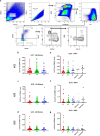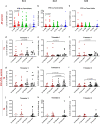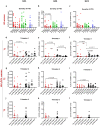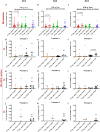Innate lymphoid cells are reduced in pregnant HIV positive women and are associated with preterm birth
- PMID: 32764636
- PMCID: PMC7413261
- DOI: 10.1038/s41598-020-69966-0
Innate lymphoid cells are reduced in pregnant HIV positive women and are associated with preterm birth
Abstract
Preterm birth is the leading cause of neonatal and child mortality worldwide. Globally, 1.4 million pregnant women are estimated to be living with HIV/AIDS, the majority of whom live in sub-Saharan Africa. Maternal HIV infection and antiretroviral treatment (ART) have been associated with increased rates of preterm birth, but the underlying mechanisms remain unknown. Acute HIV infection is associated with a rapid depletion of all three subsets of innate lymphoid cells (ILCs), ILC1s, ILC2s and ILC3s, which is not reversed by ART. ILCs have been found at the maternal-fetal interface and we therefore investigated the potential association between maternal HIV infection, peripheral ILC frequencies and preterm birth. In our study of pregnant South African women with accurately dated pregnancies, we show that maternal HIV infection is associated with reduced levels of all three ILC subsets. Preterm birth was also associated with lower levels of all three ILC subsets in early pregnancy. ILC frequencies were lowest in HIV positive women who experienced preterm birth. Moreover, ILC levels were reduced in pregnancies resulting in spontaneous onset of preterm labour and in extreme preterm birth (< 28 weeks gestation). Our findings suggest that reduced ILC frequencies may be a link between maternal HIV infection and preterm birth. In addition, ILC frequencies in early pregnancy may serve as predictive biomarkers for women who are at risk of delivering preterm.
Conflict of interest statement
The authors declare no competing interests.
Figures





References
-
- UNIGME, Levels & trends in child mortality: report 2018, estimates developed by the united nations inter-agency group for child mortality estimation (New York, 2018).
-
- Platt MJ. Outcomes in preterm infants. Public Health. 2014;128:399–403. - PubMed
-
- WHO. World health organization global health observatory (GHO) data. Number of people (all ages) living with HIV (2017).
-
- UNICEF, Elimination of mother-to-child transmission (2018).
Publication types
MeSH terms
LinkOut - more resources
Full Text Sources
Medical

